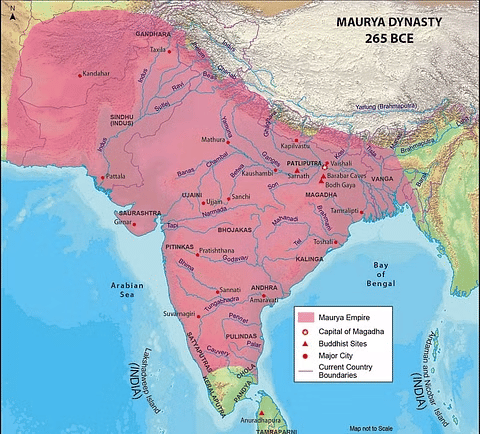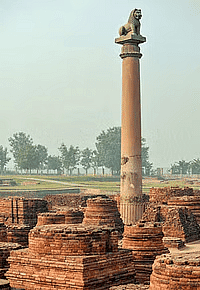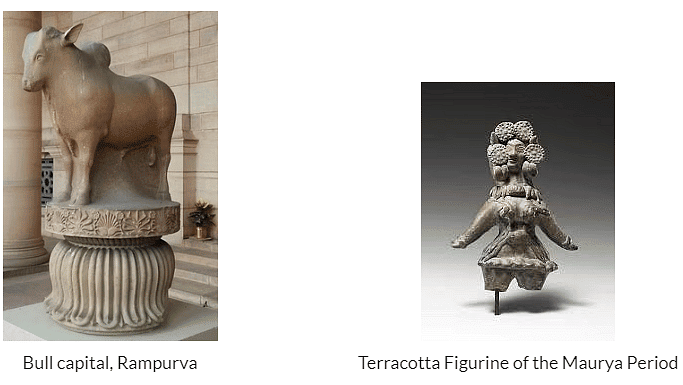Old NCERT Summary (RS Sharma): Significance of the Mauryan Empire | History for UPSC CSE PDF Download
| Table of contents |

|
| Introduction: |

|
| State Control |

|
| Economic Regulations |

|
| Spread of Material Culture |

|
| Causes of the Fall of the Maurya Empire |

|
| Conclusion |

|
Introduction:
The era of the Maurya Empire marked a significant chapter in ancient Indian history, characterized by the rise and subsequent decline of a powerful imperial dynasty. The intricate interplay of political, social, and economic factors contributed to the fall of this once-mighty empire. This article delves into key aspects led to the disintegration of the Maurya Empire, including the Brahmanical reaction, financial crises, oppressive rule, the spread of new material knowledge, and the neglect of strategic frontiers. Each factor played a pivotal role in shaping the trajectory of the empire's downfall, and understanding these dynamics is crucial for unraveling the complexities of ancient Indian history.
 Mauryan Empire
Mauryan Empire
State Control
Guidance from Brahmanical Law-books:
- The king was advised to adhere to the laws laid down in the Dharmasastras and the prevailing customs in the country.
- Kautilya, often identified with Chanakya, emphasized the king's role as the promoter (dharmapravartaka) of the social order based on varnas (class system) and asramas (stages in life).
Assertion of Royal Absolutism:
- Military conquests by the Magadha princes led to the annexation of various regions, resulting in the consolidation of the Magadhan empire.
- This military control transformed into a comprehensive control over various aspects of people's lives, leading to the assertion of royal absolutism.
Administrative Machinery:
- The need for control in all spheres of life required a vast bureaucracy.
- The Mauryan era is highlighted for having an extensive administrative system with numerous officers.
Espionage and Intelligence Gathering:
- The state maintained an elaborate system of espionage to collect intelligence about foreign enemies and monitor the activities of officers.
- Spies played a role in financial matters, including the collection of money through superstitious practices.
Functionaries and Payment Disparities:
- Important functionaries, such as ministers, high priests, commanders-in-chief, and crown princes, received substantial payments, with the highest-ranking officials earning as much as 48 thousand panas.
- There were significant disparities in payments, with lower-ranking officers receiving much less, as little as 10 or 20 panas.
Bureaucratic Structure:
- The term "tithas" is mentioned, likely referring to important functionaries within the administrative structure.
- The bureaucracy of the Mauryan period was characterized by a hierarchical structure with varying levels of payments for different ranks.
Economic Regulations
Appointment of Superintendents:
- The state appointed 27 superintendents (adhyakshas) primarily to regulate economic activities, including agriculture, trade, commerce, weights and measures, crafts, and mining.
Employment of Slaves in Agriculture:
- The Arthasastra of Kautilya suggests a social development during the Maurya period – the employment of slaves in agricultural operations. This was a significant departure, as domestic slaves were present in India from Vedic times, but large-scale agricultural use of slaves appears to have started during the Maurya era.
Royal Control and Strategic Position:
- Royal control extended over a large area, particularly in the core of the empire, facilitated by the strategic position of Pataliputra. The capital served as a central location from which royal agents could navigate in all directions.
Roads and Transportation:
- The existence of a royal road from Pataliputra to various regions, including Nepal, Vaisali, Champaran, Kapilavastu, and Peshawar, facilitated transportation.
- Various roads connected different parts of India, promoting trade and communication.
Population and Army Size:
- The Maurya rulers did not have to manage a large population. The army size did not exceed 650,000 men, indicating a relatively small population under Maurya rule.
Taxation System:
- The Maurya period marked a landmark in the system of taxation in ancient India. Kautilya outlined many taxes to be collected from peasants, artisans, and traders, requiring an efficient machinery for assessment, collection, and storage.
Imperial Currency and Taxes:
- The Mauryas used punch-marked silver coins as imperial currency, contributing to tax collection and payments to officers in cash. The uniformity of the currency facilitated market exchange.
Art and Architecture:
- The Mauryas made a remarkable contribution to art and architecture. They introduced widespread stone masonry and built impressive structures, such as the Maurya palace at Pataliputra.
- Maurya artisans displayed high technical skill in carving stone pillars, some of which were polished and embellished with sculptures of lions or bulls.
- The Maurya period saw the initiation of cave architecture, with examples like the Barabar caves near Gaya.

Spread of Material Culture
Creation of Well-Organized State Machinery:
- The Mauryas established a well-organized state machinery within the heart of the empire.
Trading and Missionary Activities:
- Maurya conquests opened doors for trading and missionary activities.
- Contacts established by administrators, traders, and Jain and Buddhist monks led to the spread of material culture from the Gangetic basin to the periphery of the empire.
Elements of Gangetic Material Culture:
- New material culture in the Gangetic basin included an intensive use of iron, punch-marked coins, Northern Black Polished ware (NBP), burnt bricks, and ringwells.
- Rise of towns in northeastern India marked a significant development.
Spread of Iron Technology:
- The use of iron implements, such as socketed axes, sickles, and possibly ploughshares, became prevalent during the Maurya period.
- The use of iron tools spread beyond the Gangetic basin to distant parts of the empire.
Use of Burnt Bricks:
- Burnt bricks were used for the first time in northeastern India during the Maurya period.
- Structures made of burnt bricks were found in Bihar and Uttar Pradesh, contributing to the flowering of towns in different parts of the empire.
Ringwells:
- Ringwells, introduced during the Maurya period, spread beyond the heart of the empire.
- They served as a water supply for domestic use and soakage-pits in congested settlements.
Transfer of Gangetic Material Culture:
- Elements of middle Gangetic material culture were transferred with modifications to northern Bengal, Kalinga, Andhra, and Karnataka.
- Material culture reached areas like Sisupalgarh in Orissa, possibly through contact with Magadha.
Spread of Material Culture to Lower Deccan:
- Material culture percolated through Maurya contacts into the lower Deccan plateau, influencing regions like Andhra and Karnataka.
Steel Technology:
- The spread of steel technology may have occurred through Maurya contacts, leading to the use of better cultivation methods in Kalinga.
Satavahana Empire:
- The Satavahana empire in the Deccan projected some administrative units of the Mauryas, and Buddhism flourished similar to the Mauryan era.
Spread of Gangetic Culture in Distant Areas:
- Attempts were made to spread elements of middle Gangetic basin culture in distant areas, including Bangladesh, Orissa, Andhra, and Karnataka, from around 300 B.C.
Policy of Acculturation by Asoka:
- Asoka implemented a deliberate and systematic policy of acculturation, fostering contacts with tribal people and encouraging them to adopt the habits of settled, taxpaying, peasant society.

- Asoka implemented a deliberate and systematic policy of acculturation, fostering contacts with tribal people and encouraging them to adopt the habits of settled, taxpaying, peasant society.
Causes of the Fall of the Maurya Empire
Brahmanical Reaction:
- The brahmanical reaction started as a result of Asoka's policies, which were perceived as affecting the income and privileges of the Brahmanas.
- Despite Asoka's tolerant policy, the Brahmanas developed antipathy, and some new kingdoms that emerged post-Maurya were ruled by Brahmanas.
Financial Crisis:
- The enormous expenditure on the army and bureaucracy created a financial crisis for the Maurya Empire.
- Despite various taxes, large grants made by Asoka to Buddhist monks left the royal treasury empty, and the empire had to resort to melting gold images to meet expenses.
Oppressive Rule:
- Oppressive rule in the provinces, particularly during the reign of Bindusara, led to citizen complaints and dissatisfaction.
- Asoka's attempts to address oppression were not entirely successful, and Taxila took the opportunity to rebel after his retirement.
Spread of New Material Knowledge:
- Once the knowledge of material culture spread to central India, the Deccan, and Kalinga due to the expansion of the Magadhan empire, the Gangetic basin lost its special advantage.
- The regular use of iron tools coincided with the decline and fall of the Maurya empire, and new kingdoms, such as the Sungas, Kanvas, Chetis, and Satavahanas, emerged based on this material culture.
Neglect of the North-West Frontier and the Great Wall of China:
- Asoka's preoccupation with missionary activities left the north-western frontier vulnerable.
- Unlike the Chinese ruler Shih Huang Ti, who constructed the Great Wall of China to safeguard against Scythian attacks, Asoka did not take similar measures.
- The Scythian movement towards India, along with the invasions of Parthians, Sakas, and Greeks, posed a serious threat.
Usurpation by Pushyamitra Sunga:
- The Maurya empire was finally destroyed by Pushyamitra Sunga in 185 B.C.
- Pushyamitra Sunga, a Brahmana and a general of the last Maurya king, killed Brihadratha and forcibly usurped the throne of Pataliputra.
- The Sungas ruled in Pataliputra and central India, marking a revival of the brahmanical way of life and persecution of Buddhists.
These factors collectively contributed to the decline and fall of the Maurya Empire.
Conclusion
In conclusion, the fall of the Maurya Empire was a culmination of multifaceted challenges that eroded the foundations of imperial power. The Brahmanical reaction, fueled by shifts in religious policies, stirred discontent among influential classes. Financial crises, stemming from extensive military expenses and lavish grants, strained the economic fabric of the empire. Oppressive rule in the provinces, coupled with the neglect of frontier defenses, weakened the Maurya grip on its vast territories. Simultaneously, the spread of new material knowledge beyond the Gangetic heartland contributed to the rise of rival kingdoms. The demise of the Maurya Empire at the hands of Pushyamitra Sunga marked the end of an epoch, paving the way for subsequent dynasties and shaping the course of Indian history.
|
216 videos|853 docs|219 tests
|
FAQs on Old NCERT Summary (RS Sharma): Significance of the Mauryan Empire - History for UPSC CSE
| 1. What were the economic regulations implemented by the Maurya Empire? |  |
| 2. How did the Maurya Empire spread material culture? |  |
| 3. What were the causes of the fall of the Maurya Empire? |  |
| 4. What was the significance of the Mauryan Empire? |  |
| 5. How did state control impact the Mauryan Empire? |  |
















